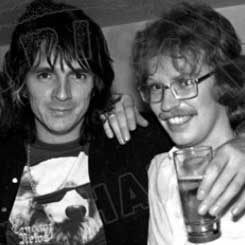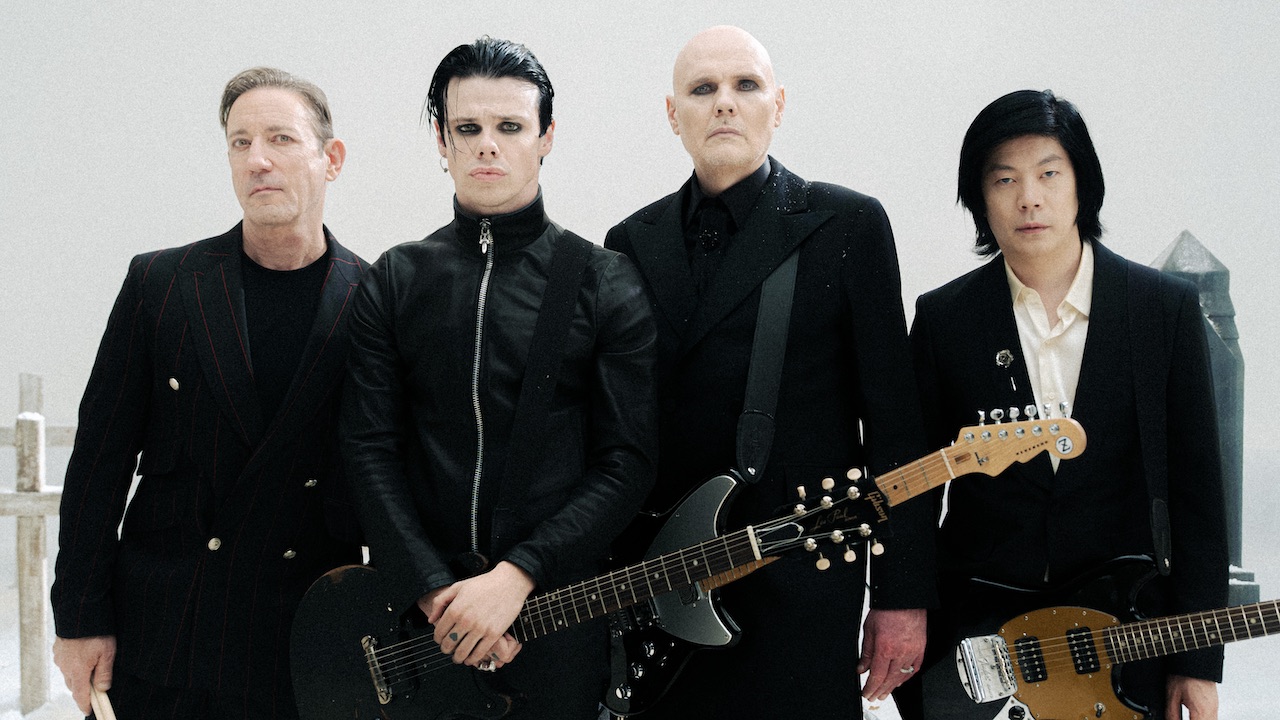You can trust Louder
Unless you’ve been living in a cave in Borneo this past year or so – and, given these COVID-troubled times, it’s perfectly possible – you’ll likely have noticed that the latest so-called ground-breaking musical phenomenon is (peal of trumpets ahoy) the New Wave Of Classic Rock – or NWOCR for short shorts.
But let’s ignore that surprise Royal Teens/Freddie And The Dreamers reference and instead suggest that said phenomenon should be called ‘Knocker’ – in much the same way as the New Wave Of British Heavy Metal, or NWOBHM, is pronounced ‘Ner-wobbum’. (That enough acronyms for ya, Line Of Duty fans? Not if this OCU – Old Critic, Undeniably – has anything to do with it.)
Now S-CG-BMPs, they come and they go. Some leave an indelible impression – punk, grunge, garage, thrash, new wave, nu metal, New Romantic, krautrock, hair-metal, pomp-rock, emo, Britpop, the aforementioned NWOBHM and many, many more.
Others not so much. Garry Bushell’s notorious Oi! fandango admittedly caused plenty of fuss and bother, albeit for all the wrong reasons, but does anyone remember his follow-up foray Punk Pathetique, spearheaded by the Toy Dolls’ Nellie The Elephant? Thought not.
Meanwhile, was Futurism ever even a wotsit? The mod renewal? Third-wave ska? Skunk rock? Crunkcore? Romo? Bonk rock? Coastal lifestyle acoustic rock? Kawaii metal? Hawaii Metal? The above musical inventions – because they were inventions – withered on the vine and singularly failed to impress Joseph and Josephine Public.
So, to the nub of the matter: is this Knocker thing a genuine, cast-iron, actual… thing? Frankly, the jury’s out in this here courthouse. The following might be a simplistic viewpoint, but surely a true classic rock band should include at least one, and ideally all, of the following:
1. A fuzzy-chested frontman poncing about in a loose cheesecloth blouse in the manner of the late David Byron. Unless it’s a frontwoman.
Sign up below to get the latest from Classic Rock, plus exclusive special offers, direct to your inbox!
2. A classically oriented keyboard wizz apt to grapple with a pulsating Hammond (à la the great Jon Lord).
3. A zebra-suited bass player straddling their on-stage monitor like they’re breaking a bareback palomino… hmm, a vision of Pete Way inexplicably springs to mind.
4. A drummer to play a solo while the rest of the band ‘enjoy a breather’.
5. Epic songs that endure way beyond the three- to four-minute, Planet Rock-approved ditties on this behemoth, 42-track Knocker showcase.
6. Finally, and most importantly, an all-seeing, all-knowing, Odin-like guitar deity delivering solos of unimaginable dexterity via the merest flick of an insouciant wrist. Yes, Mr Blackmore, that means you. Or maybe Ozzy’s sometime sideman, Greek six-stringer Gus G, a man who puts the ‘ouzo’ into ‘virtuoso’. Must admit, there’s precious little of the above on NWOCR Volume One.
But time moves on. The 1970s – the era of the idealistic classic-rock vision described above – is a decade of distant memories; as distant to this writer’s own children (all aged 30 and above) as 1940s music-hall wackos Flanagan & Allen were to yours truly when I was my kids’ age.
So… let’s cut these Knocker guys – and gals – some slack, shall we? Let’s punt forward the claim that the multifarious acts featured on this album genuinely are a new-fangled farrago of shit-hot shit-kickers who, while taking their inspiration from rock’s illustrious past, are turbo-charging forward into a golden future.
Two examples from compilations of old. The debut Metal Massacre album, issued in 1982 – a vital vinyl vignette featuring a lethal line-up of all-new US mayhem merchants unencumbered by the stodginess of Boston, Styx, Kansas et al – included a single track from Metallica: Hit The Lights. Hell, within a nano-second of listening to RTL, one instinctively knew that these fresh-faced San Fran frashers were headed for stadium greatness. The other MM bands, Cirith Ungol aside, weren’t so much in the running as hobbling around on woodworm-infested crutches.
Similarly, the first Metal For Muthas album – the infamous NWOBHM compilation from 1980 – included a brace of tracks by a fledgling Iron Maiden: Sanctuary and Wrathchild. Again, it was immediately, blindingly obvious that Steve Harris and his chundering chums easily had the chutzpah to become worldbeaters. And so it proved. (Toad The Wet Sprocket, not so much.)
So… does one get the same feeling from this Knocker krew? Does one’s Spidey sense tingle the moment one hears J Jonah Jameson… sorry, Jack J Hutchinson, whose track World On Fire is admittedly one of the weakest here? Nope, it does not. At no point does one get the feeling that here we have a posse of potential London O2 Arena headliners, Hammersmith Odeon (as was) headliners, or even, in a couple of catastrophic cases, Retford Porterhouse headliners.
It’s all a bit… meh. It’s like those heart monitor gadgets you see in Holby City: the ailing patient is in recovery; the life-threatening zig-zag peaks have stabilised; a cheese sandwich is on the way from the hospital canteen. Yet what we really need on this twin-CD doo-dah is an emergency jolt of panic and confusion, a beleaguered doc swigging from a hip flask and wielding a bloody scalpel… a moment when the NWOCR becomes the NWOCPR.
The closest glimpse of greatness comes in the form of the excellently named Wolf Jaw and the black country band’s smouldering, Zep-like I Ain’t Ready. Powerhouse guitarist/vocalist Tom Leighton’s searing refrain – ‘I can’t find no soul in this body of mine… no soul of mine, yeah!’ – will have you quaking in your pixie boots, guaranteed.
Meanwhile, the Most Original award is a no-brainer. In Ward XVI’s Broken Toys the jangling tones of a circus calliope punctuate harrowing memories of a seriously troubled childhood: ‘Barbie lost her legs too, but I tied them up with superglue.’ The band’s mantra is ‘maximum security for the mentally insane’, but one suspects it would take a billion-dollar Alice Cooper budget to turn their freakish visions into on-stage reality.
Other highlights are Blackpool glamsters Takeaway Thieves’ tinny-sounding This Is Rock’N’Roll unwittingly channelling Ray Zell’s mischievous Marionette. Ex-Amorette Gill Montgomery rehabilitating herself in some style as part of the – equally – excellently named the Hot Damn! and their track Dance Around, pleasingly reminiscent of a punkish Pat Benatar. Swedish girl group Thundermother giving the woke generation a right old seeing-to with their melodious Judas Priest shtick and the tacky Travelodge temptation: ‘Sweet honey come, here’s a room key/Tonight’s the night, you’re my VIP.’ Comedic country-rockers Bootyard Bandits – from ‘the Wild West of Worcester’ – doing much the same with the refrain: ‘There’s gonna be a hoedown showdown/Gonna drink and a-dance and a-fornicate all night.’ John Drake (taking a break from his secret-agent role in TV’s Danger Man) contributing impressive vocal pyrotechnics to The Dust Coda’s moody stomper When The Tide Comes In. Blackwater Conspiracy’s genuinely uplifting Soul Revolutionaries: richer than Jeff Bezos’ bank account, ultra-bluesy, uplifting, triumphant. King Creature’s Captives, a chunky grunge tidbit with sneering Layne Staley vocals and the decidedly creep-show coda: ‘Do you like the cage I made you?/A place where you’ll forever be/It’s somewhere that I keep you somewhere safe from me.’ Budgerigars of the world beware.
So, yes, that’s the good stuff. But the remainder? Well, for starters it’s a shame this collection kicks off with Massive Wagons having a right strop on the Lizzy-tinged Tokyo: ‘They won’t play us on the radio/They won’t put us on the road to Tokyo.’ They won’t put them on the road to Nuneaton at this rate. CD 2 begins with a similarly damp squib: Phil Campbell And The Bastard Sons’ Motorhead-lite Son Of A Gun.
There’s more. Sugarcoated bluester Elles Bailey’s Woman Like Me sounds like Shania Twain singing Black Velvet, stretching the bounds of NWOCR credibility to breaking point. South Wales girl trio Haxan evoke the wearisome spirit of Rock Goddess on Killing Time; surely there must be a more interesting femmerock inspiration from the past? Oral, maybe? A cover of Gas Masks Vicars And Priests… Now that would be a must-hear, m’dear. Bastette (aka Blackburn’s Caroline Kenyon) offers the innocuous Talk About It while purporting to be ‘the bastard love child of Ozzy Osbourne and Katy Perry’. It’s enough to set Sharon on the rampage with a blunt machete.
Eventually, everything becomes a bit of a blur. As one member of this writer’s household said, having undergone a day-long barrage of Knockerdom: “Everything sounds the same, doesn’t it?”
To a certain extent, that is true. Despite copious note taking, this writer cannot recall the differences between Revival Black and Empyre, or indeed Twister and the New Roses (yeah, Neuroses, we geddit). It’s like a lockdown beer’n’box-set binge – you watch multiple episodes of some series or other backto-back before you fall asleep. And when you wake up you can’t remember if it was Sons Of Anarchy or The Good Place.
As a final resort one is left to rely on renowned metalhead Billy Joel to put everything into a NWOCR perspective: ‘Everybody’s talkin’ ’bout the new sound – funny, but it’s still rock and roll to me.’
This is NWOCR Volume One is officially released on July 23, and can be ordered online.
Geoff Barton is a British journalist who founded the heavy metal magazine Kerrang! and was an editor of Sounds music magazine. He specialised in covering rock music and helped popularise the new wave of British heavy metal (NWOBHM) after using the term for the first time (after editor Alan Lewis coined it) in the May 1979 issue of Sounds.


